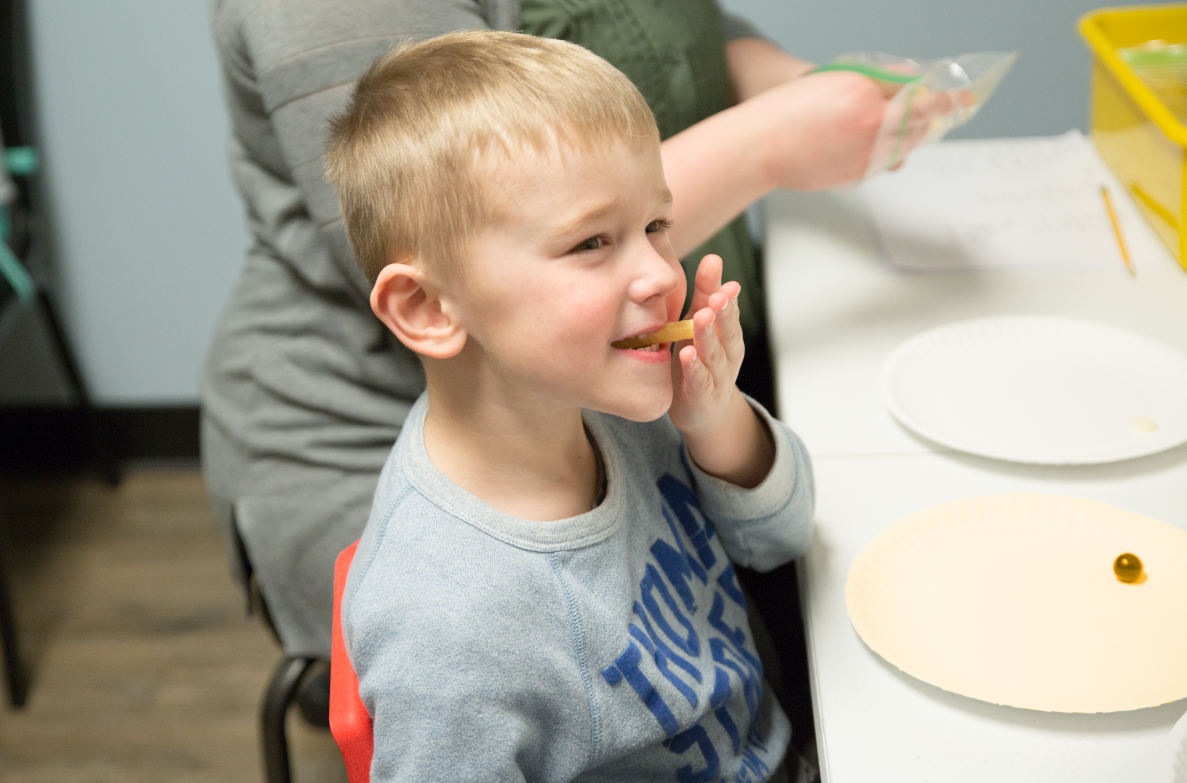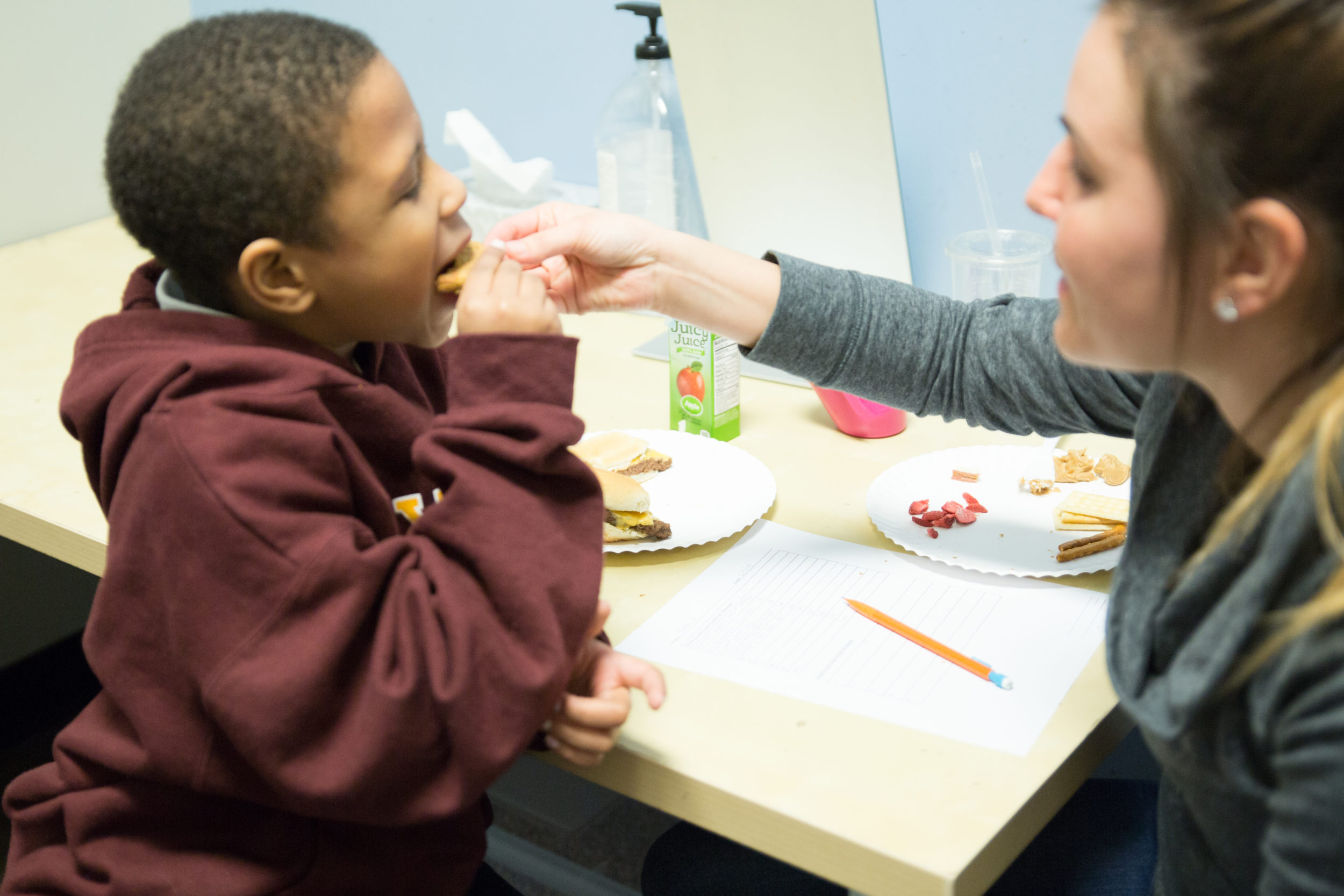Let’s first talk a little about feeding therapy as a whole and what it involves.
Pediatric feeding therapy sessions at Westside address children with feeding and swallowing difficulties in multiple way. Eating is the most complex behavior a body can perform. Eating involves the entire sensory system, all organs, muscles, learning and development based on age, nutritional status, and environment.
There are two different types of feeding therapy: Medical-based and Sensory/Oral Motor-based. Today we are going to touch on what a sensory/oral motor session can look like for your child in feeding therapy.
Sensory / Oral Motor-Based Feeding Therapy
Sensory and oral motor-based pediatric feeding therapy as known as our “picky eaters & problemed feeders” is always comprised of 3 components:
- Sensory Deficits
Examples of sensory deficits in feeding can include: overstuffing, poor food tolerance, food avoidance, refusing whole food groups based on texture, gagging on various textures, tactile deficits or inability to touch various textures or new food items, temperature rejection and or the inability to tolerate or try food items due to sensory overstimulation. - Oral Motor Deficits
Examples of oral motor deficits can include: poor lingual lateralization which can impede a child’s ability to get a solid food item to their posterior molar to begin to chew, immature chewing pattern, over stuffing, poor bolus formation, gagging on food items, pocketing of food items in cheeks and/or food residue post swallow. - Behavioral
As all feeding sessions look different and are individualized based on your child’s needs, there are many main characteristics that are carried across all feeding sessions.
If you’re asking: How do I know if my child needs pediatric feeding therapy? There are some red flags to look for if pediatric feeding therapy is necessary and some can vary child to child.
Signs That Your Child May Need Pediatric Feeding Therapy
- Restricted range or variety of foods, usually less than 20 different foods.
- Foods lost due to “burnout” are NOT re-acquired within 2 weeks.
- Cries and “falls apart” when presented with new foods.
- Refuses entire categories of food textures.
- Reduce fluid intake
- Mealtime vomiting
- Mealtime gagging
- Prolonged chewing of food items
- Pocketing of food items on cheeks, under tongue and/or on roof of mouth.
- Choking on various food items consistently.
- Inability to tolerate others eating around them.

Let’s learn about what happens during a pediatric feeding therapy session at Westside:
For privacy reasons, the child’s name, the Westside feeding therapist’s name, or the Westside location will not be named. For comparison purposes, the child in the feeding session is 3 years old.
Now here is an example of an actual patient currently attending a pediatric feeding therapy session at Westside Children’s Therapy to help better put into perspective what pediatric feeding therapy really is. The child was evaluated for Feeding Therapy due to parent concerns that their child chews meat (e.g. steak, pork) for a prolonged period of time. In addition, when consuming higher level food items, they expressed that at times they gag on them and tends to pocket them in their cheeks.
Parents stated their child has favorite foods and foods that they do not engage with and will not try within the home. The child participates in “food play.” That will be touched on more later. The child’s primary challenges revolve around chewing the food and moving it around their mouth to then swallowing.
How does the pediatric feeding therapy session start?
Pediatric feeding therapy begins with a couple minutes of sensory integration activities to increase sensory awareness, target desensitization and increase tactile input prior to the start of the session. Since typical mealtimes are approximately 15-25 minutes of true oral consumption, sensory integration tasks and oral sensory tasks “waking up your mouth” are great ways to help calm an anxious eater and increase oral motor skills.
A key component of pediatric feeding therapy for children is to keep consistency between therapy and mealtime at home. Since the child — and most others — only receives therapy for 45 min to an hour per week, it is important that what is worked on is carried over to the home environment. Which brings us to the difference between home meals and therapy meals.
- Home meals target volume of preferred food items with integration of new items that have been successful in therapy sessions.
- Therapy meals target exploration and integration of non-preferred food items, sensory integration, increasing oral motor skills and reducing behaviors during mealtimes that impede oral consumption. Therapists work hand-in-hand with parents to ensure carryover within the home isn’t overwhelming to the child and the child will still maintain his oral intake within the home.
Therapists work to create positive experiences with food for children in pediatric feeding therapy. If a child has negative experiences with food, is forced to try or eat new foods at home or in therapy, this can set back progress. That is why mealtime should be child-led with respect for their boundaries.
What’s happening during the pediatric feeding therapy session?
Many pediatric feeding therapy sessions start with sensory integration tasks as previously mentioned. Based on how sensitive and willing the child is, oral motor exercises are typically targeted. These exercises are designed to increase oral awareness, strength, range of motion and coordination of all oral structures required for successful oral feeds. These exercises are tailored to each child based on their oral motor needs.
Many times the feeding therapist and the child will perform these exercises together to increase accuracy and tolerance. Verbal praise and encouragement is provided throughout the entire session to ensure all experiences are positive across all targeted tasks.
Assessment of skills are constantly and closely monitored throughout the entire session. Activities can be increased in difficulty and/or decreased in difficulty based on the needs of your child.
Let me give you an example…
Is the child chewing food correctly?
A common concern we see in young children is an immature chewing pattern based on the food item they are trying to consume.
Correct chewing involves the use of your child’s tongue, cheek muscles, posterior biting surfaces all to work in coordination to produce a productive chewing pattern to break items down. Now, the reason we don’t say “back teeth or molars”, is because you do not need teeth to chew, you need teeth to tear apart food items. Now as a child’s diet progresses, molars are a necessity for proper breakdown of high level food items (e.g. meat, crunchy food items, etc..) With support, exercises and modeling, we aim to encourage the child to produce a correct chewing pattern and encourage carryover across all textures. You may hear your feeding therapist say over and over. “Move it to your back teeth and crunch, crunch, crunch!”
As the child moves across all the different food items presented, preferred and non preferred, proper oral motor skills are constantly monitored along with any sensory aversions that may impede the child in progressing with that food item. Sensory/food aversions are targeted using a systematic progressive approach in pediatric feeding therapy.
You may hear your therapist say “Ohhh, let’s give it a smell; it smells fresh!” or “Let’s give our food a really quick lizard lip with the tip of our tongues!” or “Let’s make big teeth marks in our food.” All of these steps are like climbing a ladder to the child tolerating the food item and eventually being comfortable enough to try that food item. Remember, there are 32 steps before we put any food item in our mouths! Yes, that is correct, 32! For our children with these aversions, we work at their pacing and meet them where they are at with various food items and help them climb that ladder! This is what we call food exploration. During this stage of pediatric feeding therapy, volume is not the main target, exploration and breaking down their aversions are.
Keep feeding and mealtime fun, engaging, and child-led
Let’s talk a little about food exploration…
FOOD SHOULD BE FUN!!! GET MESSY!!
These are statements that may be hard to grasp as we are constantly telling our children, “Don’t make a mess.” or “Stop playing with your food and eat it.” These are phrases you will never hear in pediatric feeding therapy.
We want to make eating and mealtimes fun again and less stressful. Our food therapists strive to make every experience throughout their session a positive one. Here are some examples: Making a house out of waffles or hershey bars, making sand out of crushed up cereal and driving a piece of celery through it like a bulldozer, or painting in chocolate syrup or barbeque sauce. All of these interactions are created to target all sensory inputs: visual, touch, smell, taste, body awareness and movement/balance.
Fun fact! There is actually an 8th sense called interoception. The sense has to do with the awareness of your body’s internal cues. This plays a lot of feeding as this has to do with your child feeling full, hungry or anxious when a new food item is presented they are unsure of.
This helps with food exploration and it is encouraged that if possible, the child eats what the parents are eating and that family mealtime is happening. This helps build positive experiences.
If a child sees you, the parent, eating, they may try to mirror what you are doing or simply copy you as they would if you made a funny noise, made a funny face, etc.
During this pediatric feeding therapy session, the child became upset. When this happens and the child does not want to sit at the table, the therapist comforts the child and does not force them to “finish your food before you leave the table.” With that said, a child should also not be coerced into eating by saying “If you finish, you can play on the iPad.”
If a child is angry or upset during the session, they may make strong associations that mealtime is not fun, scary, upsetting, etc.
Food play can also be incorporated when this happens because it is light and fun for the child and can help them return to session and see mealtime as enjoyable.
This was when the Hershey Bar house was built. The child returned to the table and began eating again. Before throwing away food, children are also encouraged to “kiss the food goodbye.” It’s a kid-friendly way to get rid of the food, but at the same time, if they give it a kiss goodbye, maybe it will become a food they will try if it is not one already.
Our number one rule in pediatric feeding therapy: Keep it child led and positive! We want to make sure the child does not feel pressured, frustrated and/or anxious during our feeding sessions. Our goal is to push your child to meet their full potential while respecting their boundaries and expanding them.

Reasons why a child may not eat
Safety, as mentioned, is always the top priority and there are some reasons why a child won’t eat:
- Pain/Discomfort (nausea, allergies, constipation, more)
- Immature motor, oral-motor, and/or swallow skills (choking, cannot breathe and eat, overstuffing, poor hand-to-mouth coordination)
- Sensory processing concerns (modulation problems, tactile aversions, olfactory disturbances)
- Poor core and gross motor strentgh.
- Improper feeding seating. Seating is essential during mealtimes. Your child should always feel secure in their chair, at a 90 degree angle and their feet should be firmly on the ground and/or supportive surface to maintain posture.
- Learning/behavioral (impaired learning capacity, information processing problems, cognitive delays)
- Nutritional (calorie deficient, metabolic disorder)
As with all therapies, it is important to keep up with practice and recommendations from your therapist at home. Our therapists strive to always make sure our parents and families feel involved in their child’s pediatric feeding therapy sessions and part of their progress. Team work makes the dream work!
There are plenty of online parents resources that Westside provides for its families.
If you think your child may need pediatric feeding therapy or are ready to get started, call 815-469-1500 or click the link below.







